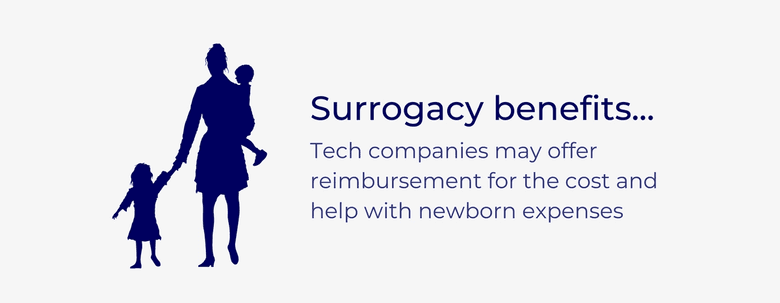Why fertility benefits are a staple in tech companies like Google
Everything you should know about fertility benefits in tech
Infertility is relatively common. About 6% of married women ages 15-44 experience infertility, and about 9% of men ages 25-44 reported they or their partner saw a doctor for infertility help, according to the Centers for Disease Control and Prevention (CDC).
Employees also seek fertility benefits for reasons other than infertility in a heterosexual relationship, including being a single parent or having a same-sex partner.
Many companies offer fertility benefits like adoption assistance, in-vitro-fertilization (IVF), and surrogacy support, going beyond federally mandated parental assistance.
But the technology industry is often more progressive with fertility benefits, compared to other industries. FertilityIQ ranked tech as the best industry for fertility benefits in their 2017-18 index for the second year in a row.
We’re taking a closer look at how these benefits work, and why companies choose to provide them.
What are fertility benefits?

When it comes to family, there are federally mandated benefits through the Family and Medical Leave Act (FMLA).
The FMLA entitles eligible employees to 12 workweeks of unpaid leave in a year for reasons including caring for a newborn or a newly adopted child.
But many companies provide benefits that go beyond the FMLA. Some offer fertility benefits to support employees trying to start a family. There are many types, including adoption assistance, IVF and surrogacy support. Let’s examine a few types of fertility benefits.
Adoption Benefits

The process and cost of adopting a child varies depending on which state or country the child is in. But no matter where you go, adoption can be expensive. Adoption costs in the US can range up to $50,000, according to Adoption Network. And if you opt for an international adoption? That cost might shoot up to $80,000.
Many employers offer adoption benefits. The benefits allow new parents to take time off during the adoption process, and even provide financial reimbursement for some expenses.
What do benefits in the tech industry look like?
Salesforce: At Salesforce, employees can secure a $10,000 adoption reimbursement per child, according to the Salesforce benefits website.
Intel: In 2015, Intel announced that they would triple their adoption monetary benefit from $5,000 to $15,000.
Microsoft: In 2018, Microsoft announced new required parental leave benefits for suppliers. The benefits also apply to parents adopting a child.
“Over the next 12 months we will work with our U.S. suppliers to implement this new paid parental leave policy. It will require that suppliers offer their employees a minimum of 12 weeks paid parental leave, up to $1,000 per week. This change applies to all parents employed by our suppliers who take time off for the birth or adoption of a child.”
Samsara: Samsara offers up to $15,000 benefits for employees trying to have children.
“We're proud to offer up to $15,000 annually in fertility, infertility, or adoption benefits for all employees looking to grow their families. New parents are provided eight weeks of paid leave and birthing parents are provided an additional 10 weeks.”
These are higher than the average employer financial reimbursement for adoption, which is a maximum of $9,000, according to the Dave Thomas Foundation for Adoption.
In-Vitro-Fertilization (IVF) Benefits

IVF is a procedure that uses medicine and surgical techniques to fertilize an egg and implant the embryo in the uterus. The procedure is often performed in cycles.
Like adoption, IVF is expensive. Depending on the patient’s city, a cycle can cost about $20,000, and patients often need multiple cycles, according to FertilityIQ.
There’s also a disparity across the country between people with IVF fertility benefits and people without. FertilityIQ explains:
“In 2017, the state of IVF reimbursement continues to be a tale of ‘haves and havenots’ with 63% of patients and employees receiving zero coverage and almost 20% receiving complete coverage.”
What do benefits in the tech industry look like?
Salesforce: Salesforce provides access to IVF assistance through Progyny, a fertility benefit company. According to the company website,
“If you're enrolled in one of our Aetna or UHC plans, you will have access to Progyny, a concierge fertility service designed to assist members who may need to pursue fertility treatment options, including egg, embryo and sperm freezing, in-vitro fertilization, artificial insemination and more.”
Facebook: Facebook also provides IVF benefits to employees on certain health plans through Progyny. A few caveats, though. You can’t share cycles with covered individuals, and you can’t get out-of-network coverage. Eligible employees can obtain four IVF cycles, according to a 2019 FertilityIQ chart.
Google: Google offers three cycles of IVF, according to a 2019 FertilityIQ chart.
Surrogacy Benefits

There are multiple types of surrogacy.
In a traditional surrogacy, a woman is artificially inseminated with sperm and carries the baby to delivery. In contrast, gestational surrogates carry the embryo that was fertilized through IVF.
What do benefits in the tech industry look like?
Salesforce: At Salesforce, which provides fertility benefits through Progyny, employees can get a $10,000 surrogacy reimbursement.
Facebook: Facebook reportedly offers $20,000 for surrogacy benefits. According to Facebook’s website, the company provides “support for family planning, including adoption and surrogacy assistance, and baby cash to help with newborn expenses.”
Why do companies provide fertility benefits?

1. Inclusive workplace
Fertility benefits, like all good job benefits, also help attract and retain talent. They make the company a more desirable place to work.
Hear from Google employees who posted about general company benefits on Glassdoor. Here's one example:
“Unnecessarily generous in every way. Google sets the bar for other companies when it comes to benefits. Benefits are so good, it creates a culture of entitlement.”
2. Recruitment and retention
Good fertility benefits can encourage employees to stay, especially when benefits in the tech industry exceed many other industries.
Only about 37% of employers with 20,000+ employees cover IVF, according to a 2018 article by Mercer, a consulting company. That’s compared to about 26% of employers with 500+ employees.
Benefits can help employers stand out from the pack during the job search process. Here’s what David Schlanger, the CEO of Progyny, told Forbes in a 2019 article:
“With a robust economy, employers are using benefits as a way to attract and retain employees. And millennials will tell you that one of the most important benefits to them within in their health coverage is coverage for fertility services.”
Take it from this Google employee on TeamBlind who says they were staying at Google in part because of the fertility benefits:
“I currently work at Google and the main reason I am staying here is due to the fact that Google pays $20k towards adoption or $40k towards surrogacy. Im feeling a desire to leave but this specific benefit really makes having kids a lot more realistic for me so it's hard to leave.”
And while fertility benefits can be priceless for some employees, the cost for employers can be low for benefits like adoption assistance, in part because relatively few employees use them, according to SHRM. That means for employers, adoption assistance can be low cost, high benefit.
3. Keeping up with the times
Certain fertility benefits, like adoption benefits, have become more common in recent years.
Childwelfare.gov says:
“A growing number of employers offer benefits to adoptive parents. In 1990, a survey by Hewitt Associates found that only 12 percent of employers surveyed offered some kind of adoption benefits; by 2004, a Hewitt survey of 936 major U.S. employers showed that the percentage had grown to 39 percent, with an average maximum reimbursement of $3,879 for adoption expenses.”
Tech companies can also be especially inclusive with fertility benefits, compared to other industries in the US. Certain non-tech companies make employees prove they are infertile in order to get fertility benefits. This can create barriers for single parents and same-sex couples.
“Intel, Facebook, Apple and Google are the best examples of such inclusion,” according to a 2017-18 FertilityIQ ranking.
By offering fertility benefits, tech companies work to create more inclusive, positive work environments.
The information provided herein is for general informational purposes only and is not intended to provide tax, legal, or investment advice and should not be construed as an offer to sell, a solicitation of an offer to buy, or a recommendation of any security by Candor, its employees and affiliates, or any third-party. Any expressions of opinion or assumptions are for illustrative purposes only and are subject to change without notice. Past performance is not a guarantee of future results and the opinions presented herein should not be viewed as an indicator of future performance. Investing in securities involves risk. Loss of principal is possible.
Third-party data has been obtained from sources we believe to be reliable; however, its accuracy, completeness, or reliability cannot be guaranteed. Candor does not receive compensation to promote or discuss any particular Company; however, Candor, its employees and affiliates, and/or its clients may hold positions in securities of the Companies discussed.
